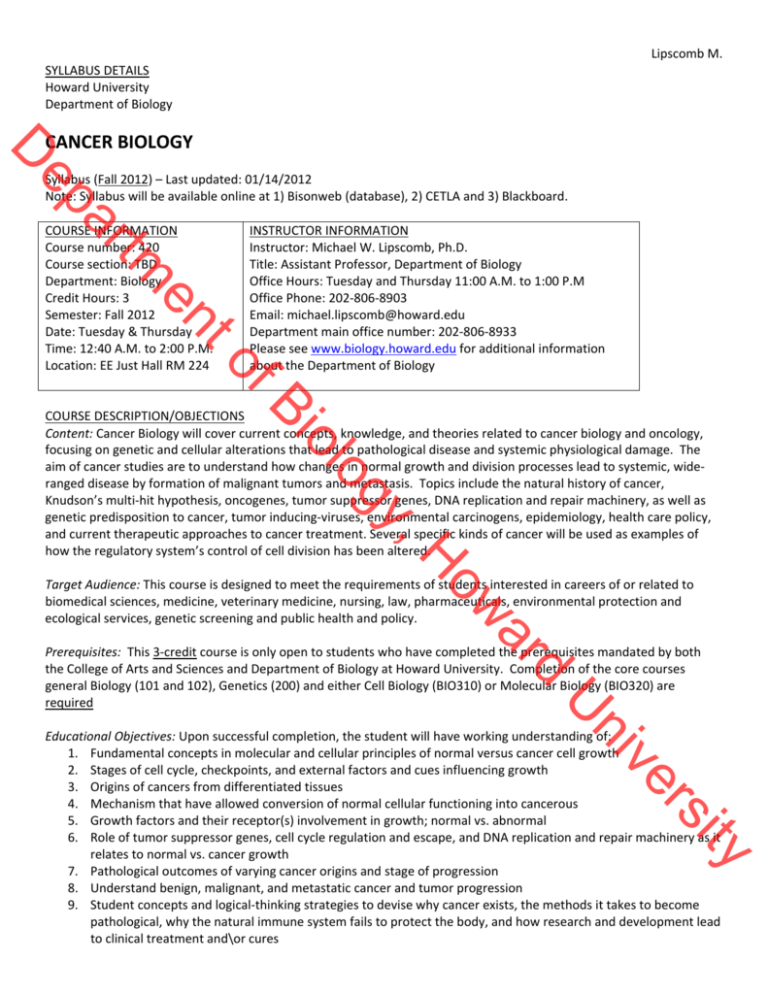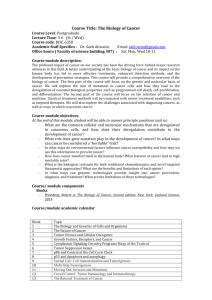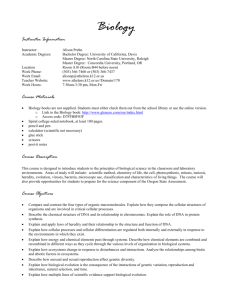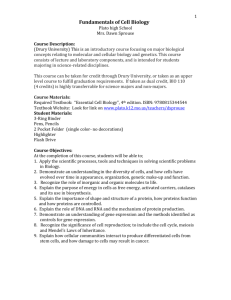Syllabus - Biology Department
advertisement

Lipscomb M. SYLLABUS DETAILS Howard University Department of Biology D CANCER BIOLOGY t en tm ar ep Syllabus (Fall 2012) – Last updated: 01/14/2012 Note: Syllabus will be available online at 1) Bisonweb (database), 2) CETLA and 3) Blackboard. COURSE INFORMATION INSTRUCTOR INFORMATION Course number: 420 Instructor: Michael W. Lipscomb, Ph.D. Course section: TBD Title: Assistant Professor, Department of Biology Department: Biology Office Hours: Tuesday and Thursday 11:00 A.M. to 1:00 P.M Credit Hours: 3 Office Phone: 202‐806‐8903 Semester: Fall 2012 Email: michael.lipscomb@howard.edu Date: Tuesday & Thursday Department main office number: 202‐806‐8933 Time: 12:40 A.M. to 2:00 P.M. Please see www.biology.howard.edu for additional information about the Department of Biology Location: EE Just Hall RM 224 COURSE DESCRIPTION/OBJECTIONS Content: Cancer Biology will cover current concepts, knowledge, and theories related to cancer biology and oncology, focusing on genetic and cellular alterations that lead to pathological disease and systemic physiological damage. The aim of cancer studies are to understand how changes in normal growth and division processes lead to systemic, wide‐ ranged disease by formation of malignant tumors and metastasis. Topics include the natural history of cancer, Knudson’s multi‐hit hypothesis, oncogenes, tumor suppressor genes, DNA replication and repair machinery, as well as genetic predisposition to cancer, tumor inducing‐viruses, environmental carcinogens, epidemiology, health care policy, and current therapeutic approaches to cancer treatment. Several specific kinds of cancer will be used as examples of how the regulatory system’s control of cell division has been altered. Target Audience: This course is designed to meet the requirements of students interested in careers of or related to biomedical sciences, medicine, veterinary medicine, nursing, law, pharmaceuticals, environmental protection and ecological services, genetic screening and public health and policy. Prerequisites: This 3‐credit course is only open to students who have completed the prerequisites mandated by both the College of Arts and Sciences and Department of Biology at Howard University. Completion of the core courses general Biology (101 and 102), Genetics (200) and either Cell Biology (BIO310) or Molecular Biology (BIO320) are required Educational Objectives: Upon successful completion, the student will have working understanding of: 1. Fundamental concepts in molecular and cellular principles of normal versus cancer cell growth 2. Stages of cell cycle, checkpoints, and external factors and cues influencing growth 3. Origins of cancers from differentiated tissues 4. Mechanism that have allowed conversion of normal cellular functioning into cancerous 5. Growth factors and their receptor(s) involvement in growth; normal vs. abnormal 6. Role of tumor suppressor genes, cell cycle regulation and escape, and DNA replication and repair machinery as it relates to normal vs. cancer growth 7. Pathological outcomes of varying cancer origins and stage of progression 8. Understand benign, malignant, and metastatic cancer and tumor progression 9. Student concepts and logical‐thinking strategies to devise why cancer exists, the methods it takes to become pathological, why the natural immune system fails to protect the body, and how research and development lead to clinical treatment and\or cures of d ar ow ,H y og ol Bi ity rs ve ni U t en tm ar ep D Lipscomb M. TEXTBOOK/READING/MATERIALS Required: Biology of Cancer. Robert Weinberg, 1st Edition. Garland Sciences 2006. The student should not have to read the textbook to understand the concepts applied in courses. Rather, the book will function as a guide or facilitator to the study of cancer by presenting overview of topics and illustrations that best serve for introduction to the subject matter. Importantly, supplemental readings will better prepare and present the entirety of how our body of knowledge in the subject has formed (see supplemental) Supplemental reading: Primary literature articles will be distributed throughout the course to support the given instruction. It is expected that the student will read and progress in ability to comprehend primary literature, effectively identifying, analyzing, and interpreting the data and proposed conclusions. Additional Comments about textbooks vs. primary literature: The book is the guide for the lectures; primary literature resources are available with the rise of the internet. Please utilize these sources in conjunction with the book to supplement teaching instructions. Lectures (Lec.) have been coordinated with the book to the best of instructor to aid in direction of presented material; all information can be additionally derived from literature sources and such. Resources: 1. Nature Reviews: Cancer. http://www.nature.com/nrc/index.html 2. National Library of Medicine: (Entrez‐PubMed; etc. Literature searches in all areas of the biomedical sciences): http://www.nlm.nih.gov/ 3. National Cancer Institute (NCI): Cancer trials, CancerNet, NCI Event Calendar, Research at NCI, Office of International Affairs, etc.: http://www.nci.nih.gov 4. Cell and Molecular Biology Online: http://www.cellbio.com/ 5. Cancer Genetics Web: http://www.cancerindex.org/geneweb/index.htm 6. Common Chemotherapy Drugs. http://www.caring4cancer.com/go/cancer/treatment/chemotherapy/common‐ chemotherapy‐drugs‐and‐side‐effects.htm References: 1. The Cancer Genome. Stratton et al. Nature. 2009 Apr 9;458(7239):719‐24. COURSE CALENDAR/SCHEDULE: Topics to be covered: of Brief Synopsis CORE I. Review of Molecular, Cellular Biology and Introduction of Cancer d Title of Lecture ar ow ,H y og ol Bi Lec. U Genetics of Cells and Organisms Basic review to the central dogma of biology; transcription and translation, organelles, mechanism of cell movement, intracellular transport, signal transduction, growth factors 2 Mutations vs. Evolution Discussion of mutations on an individual vs. evolutionary scale, introns vs. exons, gene duplication events, gene product alterations 3 Nature of Cancer and Evolution Discussion of cancer history, onset and prevalence, as it relates to the balance between evolution and fitness of a species and accumulation of mistakes in gene coding 4 The Multi‐Hit Hypothesis Handout: Knudson Hypothesis. How loss of specific checks/regulation in gene products that promote cell cycle, cell death, and DNA replication and machinery must contribute to cell immortality (i.e. cancerous) ity rs ve ni 1 CORE II. Signal Transduction Dysregulation in Cancer promotion 5 Cellular Oncogenes, Cell Discussion to the cell cycle; review of cell cycle progression, the gene and Lipscomb M. gene products intimately involved, the necessity for a system of checks and balances, and how the loss of this regulation can lead to cancer Cycle 6 Relate how external factors provide signals for changes in cell function, activity, direction, etc. and the dysregulation of this system in cancer cells. I.e., loss in reliance on growth factors to induce proliferation, loss in signaling of apoptosis. Alteration in signaling and transduction machinery Detailed examples of signaling disruption, impairment, and alterations that lead to deviant phenotypes in cell function and activities for cancerous cells. I.e. ‐ Tumor suppressor genes as regulators of the apoptotic and survival genes, how Cdk/cyclin transmit signals in a cascade to regulate cellular division. ep D Growth Factors and Receptors 7 tm ar Tumor Suppressor Genes 9 Cellular Apoptosis t en 8 Discuss the where the term ‘tumor suppressor’ is derived from, role of specific tumor suppressor genes: p35, Rb Discussion of controlled cellular apoptosis, genes that regulate apoptosis, and the necessity to control such events CORE III. DNA damage, Genomic Stability, and Disrupted DNA Repair in Cancer Promotion of 11 Maintenance of Genomic Integrity 12 Immortalization and Tumor genesis Expanded topics on repair and replication machinery, with emphasis on DNA repair as a mechanism to prevent accumulation of mutations – as a prevention to cancer onset Discuss the importance of somatic genomic integrity as a means to retaining controlled growth vs. death (i.e. cell turnover) to allow for normal organisms development and function. Discuss the global, ultimate means for loss of integrity and how this can lead to imbalance in cellular growth vs. death Discussion of the term immortalization as it pertains to uncontrolled, limitless cellular growth. Discuss how changes in gene mutations and DNA incorporation (transposition; cis vs. trans) can lead to immortalization and cancerous cells. Explore the ideas of the potential benefits and, more commonly, dangerous outcomes. ow ,H DNA Repair and Replication y og ol Bi 10 CORE IV. Tissues and Tumors – Physiological Results of Cancer Onset Biology of Angiogenesis Introduction and study of generation of blood vessels (i.e. vascularization) in organisms and the necessity of vascular system to provide tissue (i.e. cells) a means of accessing oxygen, nutrients, and water and removal of waste and toxic material. 14 Hypoxia A reduced level of oxygen in specific tissue region induces angiogenesis, a mechanism of brining more red blood cells to carry oxygen and waste to the cells. Discussion of rapid tumor growth leads to hypoxic conditions to promote tumor genesis, and how the cancerous cell can up regulate secretion of hypoxic factors to induce angiogenesis 15 Physiological Impact of Cancer Title: How does cancer kill? What are the impacts on the tissue, the organisms? Discussion of the means to which uncontrolled cell division and metastasis can lead to morbidity and death. 16 Invasion and Metastasis Details the steps necessary for cancerous cells to transition from malignancy to metastasis; discuss changes in cell‐cell junction, cytoskeletal dynamics, response to chemokine gradients d ar 13 ity rs ve ni U CORE V. Methods of Cancer Treatment 17 Tumor Immunology; Study of how the immune cells (leukocytes) identify, restrict, and destroy tumor cells. Several mechanisms are involved that allow identification of Lipscomb M. altered‐self or loss of critical immune inhibitory receptors that trigger rapid immune responses. 18 Chemotherapy and Radiation ep D Discussion of the current means to treat cancer, by both cytotoxic and cytostatic drugs that destroy target cells, with limited specificity, and abolish cellular proliferation, respectively. Discuss the mechanisms that some chemotherapeutic drugs utilized (cyclophosphamide, imatinib mesylate, taxol). Radiation 19 Surgical Oncology ar Strategic methods of surgical dissection of tissue for both preventative and treatment of tumor. 20 tm The Rationale Treatment of Cancer Emerging methods of cancer treatment; rationale for more antigen‐specific means, less non‐specific damage, and increase in quality and quantitative means. t en Required and Supplemental Readings: Prior to each lecture, relevant textbook chapters (or pages) and primary literature will be assigned. Homework: No homework assignments. Exams: There will be two exams and one final examination. For exams, there are no multiple choice, fill‐in the blank, or true/false questions. Exams will consist of short answer, short essay, and long essay questions. You will be required to answer 5 of the 6 short answer (worth 8 pts each), 3 of the 4 short essay (worth 12 pts each), and 1 of the 2 long essay questions (worth 24 pts). It can be expected that the short answer will take a maximum of 4 sentences, and the short and long essay questions taking ½ and 1 page, respectively. Exams will consist of all information presented during class, including lectures and case‐study questions. Makeup exams must be taken before the next class exam (see makeup exam in the course policies section below). Paper Assignment: Each student will be assigned an individual paper assignment; an illness or condition directly or indirectly related to cancer. Using the knowledge acquired in class and information from peer‐reviewed journal publications, the student will provide the mechanism of cancer onset and progression, the clinical and molecular pathology, and present a case for how to solve or work‐around the deficiency, whether through prevention, intervention, or therapies. Additional concerns and comments might address environmental impact (i.e. carcinogens), public health relevance and policy proposals. The assignment will be no more than four (4) pages, single‐spaced, concise and specific in the format to published research articles. Assignments will be accepted after the due date, with 10 points deducted every day (i.e., every day= inclusion of holidays and weekends). Technical specifications (adapted from Bremner, T: Euk Gene Expression): 1. Length: 6 ‐ 10 pages including references. The term paper will be accepted as should be printed on white paper (8½ x 11) using 12‐point Times New Roman (MS Word or Word Perfect). 2. Title page and page numbering: The title page should include your name and ID number, the title of your paper, the semester and year, and the name of the class, in the same font as above. The title page is page I of your paper. All other pages should be numbered consecutively. 3. Line spacing: 1.5. Margins: top and bottom, 1 inch; left, 1.25 inch, right, 1 inch. 4. Figures: No more than 2 diagrams or figures are allowed. Do not use clip art, photographs, or pictures. 5. References: No fewer than 15 references of which 70% must be less than 5 years old. No more than two references may be from textbooks. In the text, references should be numbered sequentially (the first reference is number 1) and enclosed in brackets [1]. At the end of the term paper, references should be listed in numerical order in the following format: of d ar ow ,H y og ol Bi ity rs ve ni U 6. ep D 7. 8. ar Lipscomb M. Kamijo, T., Weber, J. D., Zambetti, G., Zindi, F., Roussel, M. F., and Sher, C. J. (1998). Functional and physical interactions of the ARF tumor suppressor with p53 and Mdm2. Proc. Natl. Acad. Sci. USA 95, 8292‐8297. Avoid long, unwieldy sentences. If you are lost by the time you get to the end of your own sentence, it is likely that a reader too will be lost. Hyphenate compound words. "PMA‐induced differentiation" is not the same as "PMA induced differentiation." Similarly, the sentence quoted in (6) could be improved by placing a hyphen between anchorage and independent. Molar concentrations, cell numbers, etc. are expressed in scientific notation with the exponent written in superscript, e.g., 1.5 x 10‐7 M, 2.5 x 105 cells per ml, etc. Do not write 1.5 x 10Ù‐7). 11. Abbreviations: If the name of a cytokine or other molecule will be used repeatedly, write out the name at the first mention followed by an acceptable or standard abbreviation in parenthesis. Thereafter, use the abbreviation. For example: Interleukin‐10 (IL‐10); IL‐2 receptor (IL‐2R) bacterial lipopolysaccharide (LPS); Greek letters must be used where appropriate: TGF‐; NF‐B; IFN‐; ‐catenin, IL‐1; etc. The names of genes are written in italic to distinguish them from the proteins they encode which are written in normal font. p53 is a tumor suppressor (protein) encoded in the p53 gene. Expression of p53 produces p53 mRNA. Note that it is permissible in scientific writing to begin a sentence with a lower case letter if it is part of the name of a gene or protein. For example: v‐src, the resident transforming gene of the rat sarcoma virus, encodes v‐src, a protein tyrosine kinase that ... c‐Jun, the (protein) product of the cellular protooncogene c‐jun, heterodimerizes with c‐Fos to form the transcription factor AP‐1. Note that the "v" in v‐src and the "c" in c‐jun are not italicized. Numbers and units. Separate numbers from units (e.g., 15 mg, 10 M, 2.5 g, etc.). However, write 5%, 10%, not 5 %, 10 %, and 37oC, not 37 oC. 9. t en tm 10. of y og ol Bi 11. d ar ow ,H Homework Assignments Each week, an assignment relevant to the weeks lecture will be handed out. The assignment will contain problems and case study questions related to cancer. Your expected answer will be either short answer or short essay. Completion of the assignment is due the following week (7‐days to complete the assignment). Each assignment is worth 10 points. COURSE POLICIES: Attendance and Class Participation No attendance will be logged for this course. It is the hope of the class and the instructors that students actively attend and participate. Learning is an active process, and this course is designed to be actively engaging and not passive in learning. You are responsible for all work covered in class whether you are present or not. Students who anticipate missing class work to do official University business shall notify the instructor as soon as possible. Students who are absent for health reasons are expected to present documentation as soon as possible. Evaluation: 3 one‐hour examinations (including final): 60% of grade Term paper (See Instructions): 20% Homework assignments: 20% of grade Grading: 90‐100% = A; 80‐89% = B; 70‐79% = C; 60‐69% = D; <60% = F. Missed Exams: Makeup exams are allowable. The exam will be a different, harder variation of the exam. You will have no option to select questions to answer – all must be answered. The exam must be taken prior to the next scheduled exam or the result will be a failure of that exam. Incomplete and Withdrawal from the course: The course follows suit with the academic practices of the institution and Department of Biology; incompletes will be addressed per student basis. This will involve both the instructor and chairman of the Department. ity rs ve ni U t en tm ar ep D Lipscomb M. Academic Integrity Howard University faculty has an established code of conduct for academic integrity. Cheating and other forms of academic dishonesty will not be tolerated. For acts of academic dishonesty (cheating and plagiarism), there are three possible sanctions; these include warning, failure for the project, or failure for the courses. You are expected to have ready and comply with the “Student Code of Conduct” (particularly, plagiarism and academic dishonesty) in the Student Reference Manual (http://www.howard.edu/academics/courses/). Note: For this course, it will be difficult to commit acts of dishonesty as the exams do not contain fill in the blank, multiple choice or True/False questions. Additionally, there are no homework assignments. Grading is a result of examination, class presentations (i.e. journal club), and a paper assignment (although extra credit is offered weekly; see grading subsection). It is expected the “homework” will be in reading and working to fully understand and apply the lecture components and concepts. Special needs Howard University is committed to providing an educational environment that is accessible to all students. In accordance with this policy, students who need accommodations because of a disability should contact Dr. Barbara Williams, Dean for Special Student Services (202‐238‐2420), as soon as possible after admission to the University or at the beginning of each semester. If you need a special accommodation required by the American Disabilities Act, please document and discuss your disability with me during the first weeks of classes. * L. Dickson and T. Bremner provided direct feedback in syllabus construction ** T Bremner syllabus on Euk Gene Exp 445 was utilized as a template for construction of d ar ow ,H y og ol Bi ity rs ve ni U








